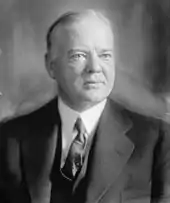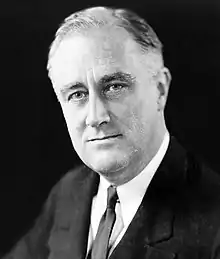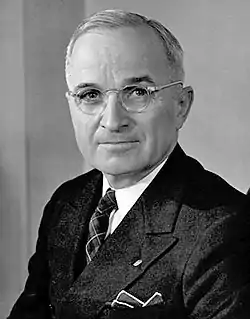Henry L. Stimson
Henry Lewis Stimson (September 21, 1867 – October 20, 1950) was an American statesman, lawyer, and Republican Party politician. Over his long career, he emerged as a leading figure in U.S. foreign policy by serving in both Republican and Democratic administrations. He served as Secretary of War (1911–1913) under President William Howard Taft, Secretary of State (1929–1933) under President Herbert Hoover, and Secretary of War (1940–1945) under Presidents Franklin D. Roosevelt and Harry S. Truman.
The son of the surgeon Lewis Atterbury Stimson, Stimson became a Wall Street lawyer after he had graduated from Harvard Law School. He served as a United States Attorney under President Theodore Roosevelt and prosecuted several antitrust cases. After he was defeated in the 1910 New York gubernatorial election, Stimson served as Secretary of War under Taft. He continued the reorganization of the United States Army that had begun under his mentor, Elihu Root. After the outbreak of World War I, Stimson became part of the Preparedness Movement. He served as an artillery officer in France after the United States entered the war. From 1927 to 1929, he served as Governor-General of the Philippines under President Calvin Coolidge.
In 1929, President Hoover appointed Stimson as Secretary of State. Stimson sought to avoid a worldwide naval race and thus helped negotiate the London Naval Treaty. He protested the Japanese invasion of Manchuria, which instituted the Stimson Doctrine of nonrecognition of international territorial changes that are executed by force. After World War II broke out in Europe, Stimson accepted President Franklin Roosevelt's appointment to the position as Secretary of War. After the United States entered World War II, Stimson took charge of raising and training 13 million soldiers and airmen, supervised the spending of a third of the nation's GDP on the Army and the Air Forces, helped formulate military strategy, and oversaw the Manhattan Project to build the first atomic bombs. He supported the atomic bombings of Hiroshima and Nagasaki. During and after the war, Stimson strongly opposed the Morgenthau Plan, which would have deindustrialized and partitioned Germany into several smaller states. He also insisted on judicial proceedings against Nazi war criminals, which led to the Nuremberg trials.
Stimson retired from office in September 1945 and died in 1950.
Early life and career

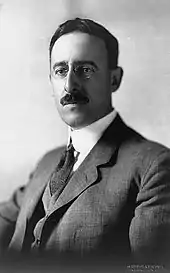
Henry Lewis Stimson was born in Manhattan, New York City, the son of Lewis Atterbury Stimson, a prominent surgeon, and his wife, the former Candace Thurber Wheeler. When he was nine, his mother died of kidney failure, and he was then sent to boarding school.
He spent summers with his grandmother Candace Wheeler at her Catskills country house and played with his nephew Dunham Wheeler, who was almost the same age, in "the Armory," which was their nickname for one corner of a large room in the house.[1][2] Roaming the Catskill Mountains, he grew to love the outdoors and would become an avid sportsman.[3]
He was educated at Phillips Academy in Andover, Massachusetts, where he gained a lifelong interest in religion and a close relationship with the school. He later donated Woodley, his Washington, DC, real estate to the school in his will (the property is now the Maret School).[4] He was an honorary lifetime member of Theodore Roosevelt's Boone and Crockett Club, North America's first wildlife conservation organization.[5] He was a Phillips trustee from 1905 to 1947 and served as president of the board from 1935 to 1945.[6][7] He then attended Yale College, where he was elected to Phi Beta Kappa. He joined Skull and Bones, a secret society that afforded many contacts for the rest of his life.[8] He graduated in 1888 and attended Harvard Law School, where he graduated in 1890. He joined the prestigious Wall Street law firm of Root and Clark in 1891 and became a partner in 1893. Elihu Root, a future Secretary of War and Secretary of State, became a major influence on and role model for Stimson.[9]
In July 1893, Stimson married the former Mabel Wellington White, a great-great granddaughter of one of the Founding Fathers, Roger Sherman, and the sister of Elizabeth Selden Rogers. An adult case of mumps had left Stimson infertile, and they had no children.[10] The couple honeymooned in Kyoto, Japan, a voyage that would prove critical in Stimson's decision not to drop a nuclear bomb on that city during the Second World War.[11]
In 1906, President Theodore Roosevelt appointed Stimson U.S. Attorney for the Southern District of New York, where Stimson made a distinguished record prosecuting antitrust cases. He later served from 1937 to 1939 as president of the New York City Bar Association, where a medal honoring service as a U.S. Attorney is still awarded in his honor.
Stimson was defeated as Republican candidate for Governor of New York in 1910.
He joined the Council on Foreign Relations at its inception[12] and was described by The New York Times as "the group's quintessential member."[13]
Secretary of War (1st term)
In 1911, President William Howard Taft appointed Stimson as Secretary of War. Stimson continued the reorganization of the army that had begun by Elihu Root, which improved its efficiency prior to its vast expansion in World War I. In 1913, Stimson left office following the accession of President Woodrow Wilson.
World War I
Following the outbreak of World War I in 1914, he was a strong supporter of Britain and France but also supported US neutrality. He called for preparation of a large, powerful army and was active in the privately funded Plattsburg Training Camp Movement to train potential officers. After the US declared war in 1917, Stimson was one of the 18 selected by former President Theodore Roosevelt to raise a volunteer infantry division, Roosevelt's World War I volunteers, for service in France in 1917.
President Woodrow Wilson refused to make use of the volunteers, and the unit disbanded. Stimson served the regular US Army in France as an artillery officer and reached the rank of colonel in August 1918. He continued his military service in the Organized Reserve Corps and rose to the rank of brigadier general in 1922.[14]
Nicaragua and Philippines
In 1927, Stimson was sent by President Calvin Coolidge to Nicaragua to negotiate an end to the Nicaraguan Civil War. Stimson wrote that Nicaraguans "were not fitted for the responsibilities that go with independence and still less fitted for popular self-government."[15] He opposed independence for the Philippines for the same reason after he had been appointed Governor-General of the Philippines, an office that he held from 1927 to 1929.[16]
Secretary of State
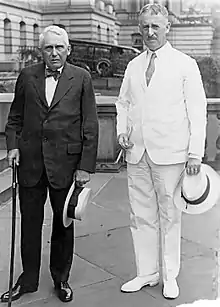
Stimson returned to the cabinet in 1929, when US President Herbert Hoover appointed him US Secretary of State. Both served until 1933. Stimson lived in the Woodley Mansion in Washington, DC, where he remained through 1946.
Shortly after being appointed as the new Secretary of State, Stimson shut down the Cipher Bureau (US cryptanalytic service) in 1929. He considered intercepting diplomatic communications unethical and famously commented, "Gentlemen do not read each other's mail."[17][18]
In 1930 and 1931, Stimson was the Chairman of the US delegation to the London Naval Conference of 1930. In the following year, he was the Chairman of the US delegation to World Disarmament Conference in Geneva. The same year, the United States issued the "Stimson Doctrine" in response to Japanese invasion of Manchuria. It stated that the US refused to recognize any situation or treaty that limited US treaty rights or was brought about by aggression.
Returning to private life at the end of the Hoover administration, Stimson was an outspoken advocate of strong opposition to Japanese aggression.
Secretary of War (2nd term)
_arrive_at_the_Gatow_Airport_in_Berlin%252C_Germany_to_attend..._-_NARA_-_198795.jpg.webp)
After World War II broke out, Roosevelt returned Stimson to his post at the head of the War Department. The choice of Stimson, a conservative Republican, was a calculated effort by the president to win bipartisan support for what was considered the almost-inevitable US entrance into the war. Ten days before the attack on Pearl Harbor, Stimson entered in his diary the following statement: "[Roosevelt] brought up the event that we are likely to be attacked perhaps next Monday, for the Japanese are notorious for making an attack without warning, and the question was what we should do. The question was how we should maneuver them into the position of firing the first shot without allowing too much danger to ourselves."[19]
During the war, Stimson oversaw a great expansion of the military, including drafting and training of 13 million soldiers and airmen as well as purchasing and transporting 30% of the nation's industrial output to the battlefields.[20] He worked closely with his top aides Robert P. Patterson, who succeeded Stimson as Secretary;[21] Robert Lovett, who handled the Air Force; Harvey Bundy; and John J. McCloy, Assistant Secretary of War.[22]
Stimson was 73 when he took the reins as War Secretary, and many critics questioned if a man of his age could tackle a job that was so enormous. He defied all naysayers and plunged into the task with "an energy that men 20 years his junior could not have mustered." However, at 75, Stimson confessed that he was "feeling very tired. The unconscious strain has been pretty heavy on me."[23]
Japanese American internment
Stimson was initially opposed to the internment of Japanese Americans away from the West Coast, but he eventually gave in to pro-exclusion military advisers and secured Roosevelt's final approval for the incarceration program. The administration was split in the wake of Pearl Harbor, with Justice Department officials arguing against "evacuation" and the Army and the War Department leaders demanding the immediate relocation. Still opposed to the idea of wholesale eviction, Stimson spent much of January 1942 in fielding calls from military advisers and West Coast politicians on the potential threat of a Japanese American fifth column. By February, John McCloy and others from the pro-exclusion camp had won him over.
On February 11, Stimson and McCloy briefed in a phone conference Roosevelt, who gave his Secretary of War the go-ahead to pursue whatever course he saw fit. McCloy contacted Karl Bendetsen to begin formulating a removal strategy immediately after. Roosevelt granted Stimson the final approval to carry out the eviction of West Coast Japanese Americans on February 17, and two days later, Roosevelt issued Executive Order 9066, which authorized the establishment of military zones that excluded certain persons.[24]
As the Western Defense Command began circulating civilian exclusion orders, a new debate formed regarding Japanese Americans in the Territory of Hawaii. Stimson joined other officials to push for the exclusion of all "enemy alien" Japanese from the islands.[24] (Japanese immigrants were prohibited by law from naturalization and so were classified as enemy aliens, regardless of their residential status.) However, Japanese Hawaiians were the largest ethnic group in the territory and the foundation of the Island's labor force. Since mass removal was infeasible both economically and politically, Stimson's proposal quickly fell through.[25]
Although Stimson believed it to be "quite impossible" to determine the loyalty of Japanese Americans and eventually came to support the army's incarceration program, he remained unconvinced on the legality of the policy: "The second generation Japanese can only be evacuated either as part of a total evacuation, giving access to the areas only by permits, or by frankly trying to put them out on the ground that their racial characteristics are such that we cannot understand or trust even the citizen Japanese. The latter is the fact but I am afraid it will make a tremendous hole in our constitutional system."[26]
Stimson authorized the release of Japanese Americans from camp in May 1944 but postponed permission for them to return to the West Coast until after the November elections to avoid controversy in Roosevelt's upcoming campaign.[24]
General Patton
On November 21, 1943, the news broke that General George S. Patton, commander of the U.S. Seventh Army, had slapped an enlisted man who suffered from nervous exhaustion at a medical evacuation hospital in Sicily.[27] The incident caused a storm of controversy, and members of Congress called for Patton to be relieved of command. General Dwight Eisenhower opposed any move to recall General Patton from the European Theater and said privately, "Patton is indispensable to the war effort - one of the guarantors of our victory."[28] Stimson and McCloy agreed; Stimson told the Senate that Patton would be retained because of the need for his "aggressive, winning leadership in the bitter battles which are to come before final victory."[29]
Morgenthau Plan
Stimson strongly opposed the Morgenthau Plan to deindustrialize and to partition Germany into several smaller states.[30] The plan also envisioned the deportation and the summary imprisonment of anybody suspected of responsibility for war crimes. Initially, Roosevelt had been sympathetic to the plan, but Stimson's opposition and the public outcry when the plan was leaked made Roosevelt backtrack. Stimson thus retained overall control of the US occupation zone in Germany, and despite the plan's influence on the early occupation, it never became official policy. Explaining his opposition to the plan, Stimson insisted to Roosevelt that 10 European countries, including Russia, depended upon German trade and its production of raw materials. He also stated that it was inconceivable that the "gift of nature," which was populated by peoples of "energy, vigor, and progressiveness," should be turned into a "ghost territory" or "dust heap."
What Stimson most feared, however, was that a subsistence-level economy would turn the anger of Germans against the Allies and thereby "obscure the guilt of the Nazis and the viciousness of their doctrines and their acts." Stimson pressed similar arguments on Harry S. Truman, when he became president, in the spring of 1945.[31]
Stimson, a lawyer, insisted, against the initial wishes of both Roosevelt and British Prime Minister Winston Churchill, on proper judicial proceedings against leading war criminals. He and the War Department, drafted the first proposals for an International Tribunal, which soon received backing from Truman. Stimson's plan eventually led to the Nuremberg Trials of 1945–1946, which have strongly influenced the development of international law.
Atomic bomb
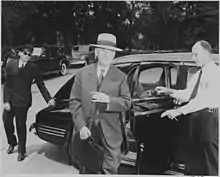
As Secretary of War, Stimson took direct and personal control of the entire atomic bomb project, with immediate supervision over General Leslie Groves, the head of the Manhattan Project. Both Roosevelt and Truman followed Stimson's advice on every aspect of the bomb, and Stimson overruled military officers when they opposed his views.[32][33] That is best seen after military planners had selected Kyoto as the most promising target in southern Japan for nuclear attack. Stimson, remembering his honeymoon in that city, once again overruled his generals:
Kyoto had been favored for the very first attack but the committee opted to blitz Hiroshima, which was an important army depot and embarkation port within an urban environment. Targets in the south were given priority to boost possible invasion plans but the ancient city of Kyoto was withdrawn because the U.S. Secretary of War, Henry Stimson, who had honeymooned there, said it was an important cultural center and "must not be bombed."[11]
The Manhattan Project was managed by Major General Groves (Corps of Engineers) with a staff of reservists and many thousands of civilian scientists and engineers. Groves nominally reported directly to General George Marshall, but Stimson was really in charge. Stimson secured the necessary money and approval from Roosevelt and from Congress, ensured that Manhattan had the highest priorities, and controlled all plans for the use of the bomb. Stimson successfully tried to get "Little Boy" (the Hiroshima bomb) dropped within hours of its earliest possible availability. Japan was to be forced to surrender, and the bombing of Hiroshima August 6 was likely a finishing blow for Tokyo.[34]
Stimson ultimately concluded that if the US had guaranteed the Japanese preservation of the imperial constitutional monarchy, Japan might have surrendered and prevented the use of atomic bombs.[35]
Stimson's vision
In retrospect, historians debate whether the impact of continued blockade, relentless bombing, and the Soviet Union's invasion of Manchuria would have somehow forced Japanese Emperor Hirohito to surrender sometime in late 1945 or early 1946 even without the use of atomic bombs but with massive Allied casualties.[36] Stimson looked beyond the immediate end of the war. He was the only top government official to try to predict the meaning of the Atomic Age, and he envisioned a new era in human affairs.[37] For half-a-century, he had worked to inject order, science, and moralism into matters of law, state, and diplomacy. The impact of the atom bomb, he thought, would go far beyond military concerns to encompass diplomacy, world affairs, business, economics, and science. Above all, Stimson stated that the "most terrible weapon ever known in human history" opened up "the opportunity to bring the world into a pattern in which the peace of the world and our civilization can be saved."[38] He thought that the very destructiveness of the new weaponry would shatter the ages-old belief that wars could be advantageous. It might now be possible to call a halt to the use of destruction as a ready solution to human conflicts. Indeed, society's new control over the most elemental forces of nature finally "caps the climax of the race between man's growing technical power for destructiveness and his psychological power of self-control and group control--his moral power."[39][40]
In 1931, when Japan had invaded Manchuria, Stimson, as Secretary of State, proclaimed the Stimson Doctrine: no fruits of illegal aggression would ever be recognized by the United States. Although Japan ignored it, according to Stimson, the wheels of justice had now turned and the "peace-loving" nations, as Stimson called them, had the chance to punish Japan's misdeeds in a manner that would warn aggressor nations never again to invade their neighbors. To validate the new moral order, he believed that the atomic bomb had to be used against combatants and workers in the war. Hiroshima and Nagasaki had both contained combatant bases and major centers of war industry that employed tens of thousands of civilians. The question for Stimson was not one of whether the weapon should be used. Involved were the simple issue of ending a horrible war and the more subtle and more important question of the possibility of genuine peace among nations. Stimson's decision involved the fate of mankind, and he posed the problem to the world in such clear and articulate fashion that there was a nearly-unanimous agreement mankind had to find a way so that atomic weapons would never be used again to kill people.[41][42][43]
Later life
Stimson officially announced his retirement on September 21, 1945. Afterwards, he wrote his memoirs with the aid of McGeorge Bundy. On Active Service in Peace and War was published by Harper in 1948 to critical acclaim. It is often cited by historians, as are the 170,000 typed pages of candid diaries that Stimson dictated at the end of every day. The diary is now in the Yale University Library; parts have been published in microfilm.[44]
Two months after leaving office, in November 1945, Stimson suffered a heart attack from which he recovered, although he suffered a speech impediment.[45] In the summer of 1950, Stimson fell and broke his leg and was confined to a wheelchair. On October 20, one month after his 83rd birthday, he succumbed to complications from a second heart attack.[46] Stimson died at his estate Highhold in West Hills, New York.[47] He is buried in the adjacent town of Cold Spring Harbor, in the cemetery of St. John's Church.[48][49]
Anecdote
Theodore H. White noted that Stimson had known and served under more Presidents than any other American citizen of his era. According to White, a short time before Stimson died, he had been asked by a friend which of the many Presidents that he had been acquainted with "had been the best." After a few moments of reflection, Stimson indicated his answer to the query depended on what was meant by "the best." He said that if it meant the most efficient man to hold the office, the answer was William Howard Taft. If, however, the question meant the greatest President, the answer was "Roosevelt," but Stimson could not decide whether the first name would be Theodore or Franklin. Stimson said both "understood the use of power" but as well "knew the enjoyment of power."[50]
Awards
- Distinguished Service Medal (U.S. Army)[51]
- World War I Victory Medal
- American Legion Distinguished Service Medal[52]
Legacy
Mount Stimson in Montana's Glacier National Park is named after Stimson, who in the 1890s hiked and assisted George Bird Grinnell in surveying the area and later supported creating the park.
The Henry L. Stimson Center, a private research institute in Washington, DC, advocates what it says is Stimson's "practical, non-partisan approach" to international relations.[53]
The Benjamin Franklin-class ballistic missile submarine USS Henry L. Stimson (SSBN-655) was commissioned in 1966.
Stimson's name graces the Henry L. Stimson Middle School in Huntington Station, Long Island; a residential building on the campus of Stony Brook University; as well as a dorm at his alma mater Phillips Academy.
Stimson is also commemorated by the New York City Bar Association, where he served as president from 1937 to 1939, with the Henry L. Stimson Medal. The medal is awarded annually to outstanding Assistant U.S. Attorneys in the Southern and Eastern Districts of New York.
In popular culture
Stimson has been portrayed in nearly a dozen movies and television shows about World War II and its aftermath, including Manhattan (2014-2015), Truman (1995), Truman at Potsdam (1995), Fat Man and Little Boy (1989), Day One (1989), War and Remembrance (1988), Race for the Bomb (1987), Churchill and the Generals (1981), Oppenheimer (1980), Tora! Tora! Tora! (1970), and The Beginning or the End (1947).
In the alternate history short story "Truth, Justice, and the American Way" by Lawrence Watt-Evans contained in the 1992 alternate history anthology Alternate Presidents by Mike Resnick, Stimson succeeded Hoover (who defeated Roosevelt in 1932 after Al Smith ran as a third party candidate and split the Democratic vote) as president in 1936, defeating Roosevelt. He once again defeated Roosevelt in 1940.
See also
- List of U.S. political appointments that crossed party lines
References
- Amelia Peck and Carol Irish (2001). Candace Wheeler: The Art and Enterprise of American Design. Metropolitan Museum of Art, New York. p. 88. ISBN 978-1-58839-002-8.
- Wheeler, Candace, The Annals of Onteora, 1887-1914, privately printed, Erle W. Whitfield, New York (1914)(Special Collections, University of Virginia Library)(p. 24)
- Candace Wheeler, Yesterdays in a Busy Life, Harper & Brothers: New York (1918) p. 299)
- "Stimson Estate Goes to Phillips Academy". The Milwaukee Journal. 1938-05-15. p. 13. Retrieved 2014-02-06.
- "Boone and Crockett Club Archives".
- Henry L. Stimson: The First Wise Man. Wilmington, Delaware: Scholarly Resources Inc. 2001. p. 4. ISBN 978-0842026314. Retrieved 2014-02-06.
- "Phillips Academy - Notable Alumni: Short List". Phillips Academy. Archived from the original on 2016-10-27. Retrieved 2014-02-06.
- Sean L. Malloy (2008). Atomic Tragedy: Henry L. Stimson and the Decision to Use the Bomb Against Japan. Cornell University Press. pp. 14–15. ISBN 978-0801446542.
- see Malloy, Ch. 1, "The Education of Henry L. Stimson"
- Conant, Jennet (2002). Tuxedo Park. Simon & Schuster. p. 24. ISBN 978-0-684-87287-2.
- Hale, Don (2015-08-14). "U.S. Planned to Drop 12 Atomic Bombs on Japan". Retrieved 2019-10-02.
- Grose, Peter. Continuing the Inquiry: The Council on Foreign Relations from 1921 to 1996. New York: Council on Foreign Relations Press, 1996. ISBN 0876091923 / ISBN 978-0876091920.
- Lukas, J. Anthony. "Council on Foreign Relations — Is it a Club? Seminar? Presidium? 'Invisible Government'?" New York Times, November 21, 1971, pp. SM34+. Archived from the original.
- "Henry Lewis Stimson". U.S. Army Center of Military History. Retrieved 5 January 2017.
- David F. Schmitz, Henry L. Stimson: the first wise man (2001) p 55.
- David F. Schmitz, Henry L. Stimson: the first wise man (2001) p 69.
- "Gentlemen Reading Each Others' Mail: A Brief History of Diplomatic Spying". The Atlantic Magazine. 2013. Retrieved 2019-04-13.
- Stimson, Henry L.; Bundy, McGeorge (1948). On Active Service in Peace and War. New York, New York, USA: Harper & Brothers. p. 188. From p. 188: "Stimson, as Secretary of State, was dealing as a gentleman with the gentlemen sent as ambassadors and ministers from friendly nations, and as he later said, 'Gentlemen do not read each other's mail.' "
- Richard N. Current, "How Stimson Meant to 'Maneuver' the Japanese," Mississippi Valley Historical Review Vol. 40, No. 1 (Jun., 1953), pp. 67-74 in JSTOR
- Herman, Arthur. Freedom's Forge: How American Business Produced Victory in World War II, pp. 83-4, 90, 94, 112-15, 121, 125-6, 139, 141, Random House, New York, NY, 2012. ISBN 978-1-4000-6964-4.
- Keith Eiler, Mobilizing America: Robert P. Patterson and the War Effort (Cornell U.P. 1997)
- Walter Isaacson and Evan Thomas, The Wise Men: Six Friends and the World They Made: Acheson, Bohlen, Harriman, Kennan, Lovett, and McCloy (1986)
- Nigel Hamilton, The Mantle of Command, 2014, p. 433.
- Niiya, Brian. "Henry Stimson". Densho Encyclopedia. Retrieved 15 October 2014.
- Scheiber, Jane L.; Scheiber, Harry N. "Martial Law in Hawaii". Densho Encyclopedia. Retrieved 15 October 2014.
- Hodgson, Godfrey. The Colonel: The Life and Wars of Henry Stimson, 1867-1950 (New York: Knopf, 1990), p 259.
- Atkinson, Rick, The Day of Battle: The War in Sicily and Italy 1943-1944, New York: Henry Holt & Co., ISBN 978-0-8050-8861-8 (2007), p. 147.
- Carlo D'Este, Patton: A Genius For War, New York: HarperCollins, ISBN 0-06-016455-7 (1995), p. 536
- D'Este, Patton: A Genius For War, p. 543
- Beschloss, Michael R. (2003-10-07). Morgenthau-Plan. ISBN 9780743244541. Retrieved 2014-07-20.
- Arnold A. Offner, "Research on American-German Relations: A Critical View" in Joseph McVeigh and Frank Trommler, eds. America and the Germans: An Assessment of a Three-Hundred-Year History (University of Pennsylvania Press, 1990) v2 p. 176; see also Michael R. Beschloss, The Conquerors: Roosevelt, Truman and the Destruction of Hitler's Germany, 1941-1945 (2002)
- Sean Malloy, Atomic Tragedy: Henry L. Stimson and the Decision to Use the Bomb Against Japan The Manhattan Project, Department of Energy at mbe.doe.gov
- "Henry Lewis Stimson". Archived from the original on 2010-06-11. Retrieved 2011-06-20.
- Art, Robert J.; Waltz, Kenneth Neal (2004). The Use of Force: Military Power and International Politics. Rowman & Littlefield. p. 179. ISBN 9780742525573.
- David F. Schmitz, Henry L. Stimson: the first wise man (2001) p 153.
- "Revisionists" who reject use of the bomb include Gar Alperovitz, The Decision to Use the Atomic Bomb (1996) and Barton J. Bernstein (1993). ""Seizing the Contested Terrain of Early Nuclear History: Stimson, Conant, and Their Allies Explain the Decision to Use the Atomic Bomb," Diplomatic History 17 (Winter 1993): 35-72". Diplomatic History. 17: 35–72. doi:10.1111/j.1467-7709.1993.tb00158.x.
- Henry Stimson to Harry S. Truman, accompanied by a memorandum, September 11, 1945. Truman Papers, President's Secretary's File. Atomic Bomb.
- Top Secret Letter From Henry Stimson, Secretary of War 24 April 1945. Retrieved 31 December 2018.
- Henry L. Stimson, On Active Services in Peace and War (1948) p. 636
- Michael Kort, The Columbia guide to Hiroshima and the bomb (2007) p. 179
- See Bonnett, John. "Jekyll and Hyde: Henry L. Stimson, Mentalite, and the Decision to Use the Atomic Bomb on Japan." War in History 1997 4(2): 174-212. ISSN 0968-3445 Fulltext: Ebsco
- McGeorge Bundy, Danger and Survival: Choices about the Bomb in the First Fifty Years (1988)
- Robert P. Newman, "Hiroshima and the Trashing of Henry Stimson" The New England Quarterly, Vol. 71, No. 1 (Mar., 1998), pp. 5-32 in JSTOR
- "The Diaries of Henry Lewis Stimson in the Yale University Library". Microformguides.gale.com. 1945-09-21. Retrieved 2014-07-20.
- Universal Press Syndicate (Nov 13, 1945). "Stimson Recovering from Heart Attack". Pittsburgh Press. Retrieved 2014-01-23.
- "Henry L. Stimson Dies at 83 In His Home on Long Island". New York Times. October 21, 1950. Retrieved 2014-01-23.
- "Henry L. Stimson, 83, Dies on LI, Served Nation in Four Cabinets". Newsday. October 21, 1950. p. 2.
- "Memorial Cemetery, St. John's Church". Retrieved October 20, 2016.
- "St. John's Church Memorial Cemetery". Oldlongisland.com. Retrieved 13 October 2017.
- White, Theodore H. (2009). The Making of the President 1960 (Harper Perennial Political Classicss ed.). New York: HarperCollins. p. 366. ISBN 978-0-06-190060-0.
- "Public Papers Harry S. Truman 1945-1953". Trumanlibrary.org. Retrieved 13 October 2017.
- "Distinguished Service Medal Recipients - Page 9 - The American Legion". Legion.org. Retrieved 13 October 2017.
- "About Stimson | The Stimson Center | Pragmatic Steps for Global Security". Stimson.org. Retrieved 2013-06-10.
Further reading
Secondary sources
- Bonnett, John. "Jekyll and Hyde: Henry L. Stimson, Mentalite, and the Decision to Use the Atomic Bomb on Japan." War in History 1997 4(2): 174–212. ISSN 0968-3445 online
- Ferrell, Robert H. Frank B. Kellogg; Henry L. Stimson (1963); as Secretary of State online
- Gerber, Larry G. "Stimson, Henry Lewis"; American National Biography Online February 2000.
- Gerber, Larry G. The Limits of Liberalism: Josephus Daniels, Henry Stimson, Bernard Baruch, Donald Richberg, Felix Frankfurter and the Development of the Modern American Political Economy (1983).
- Hodgson, Godfrey. The Colonel: The Life and Wars of Henry Stimson, 1867-1950 (1990). popular biography
- Jordan, Jonathan W., American Warlords: How Roosevelt's High Command Led America to Victory in World War II (NAL/Caliber 2015).
- Malloy, Sean L. Atomic Tragedy: Henry L. Stimson and the Decision to Use the Bomb Against Japan (2008)
- Morison, Elting E. Turmoil and Tradition: A Study of the Life and Times of Henry L. Stimson (1960), scholarly biography
- Newman, Robert P. "Hiroshima and the Trashing of Henry Stimson" The New England Quarterly, Vol. 71, No. 1 (Mar., 1998), pp. 5–32 in JSTOR
- Schmitz, David F. Henry L. Stimson: The First Wise Man (2000)
Primary sources
- Stimson, Henry and McGeorge Bundy, On Active Service in Peace and War. (1948) (memoirs)
External links
| Wikiquote has quotations related to: Henry L. Stimson |
| Wikimedia Commons has media related to Henry Lewis Stimson. |
- Obituary, New York Times, October 21, 1950
- Henry Stimson Center
- Annotated bibliography for Henry Stimson from the Alsos Digital Library
- Sherman Genealogy Including Families of Essex, Suffolk and Norfolk, England By Thomas Townsend Sherman
- Henry L. Stimson at Find a Grave
- verbatim copy of "Stimson Diary" entries regarding Atomic Bomb, Dec 1944 to Sept 1945
- Works by Henry L. Stimson at LibriVox (public domain audiobooks)

- Newspaper clippings about Henry L. Stimson in the 20th Century Press Archives of the ZBW
- Henry Lewis Stimson papers (MS 465). Manuscripts and Archives, Yale University Library.
| Party political offices | ||
|---|---|---|
| Preceded by Charles Evans Hughes |
Republican nominee for Governor of New York 1910 |
Succeeded by Job E. Hedges |
| Political offices | ||
| Preceded by Jacob M. Dickinson |
United States Secretary of War 1911–1913 |
Succeeded by Lindley Miller Garrison |
| Preceded by Leonard Wood Acting |
Governor-General of the Philippines 1927–1929 |
Succeeded by Eugene Allen Gilmore Acting |
| Preceded by Frank B. Kellogg |
United States Secretary of State 1929–1933 |
Succeeded by Cordell Hull |
| Preceded by Harry H. Woodring |
United States Secretary of War 1940–1945 |
Succeeded by Robert P. Patterson |

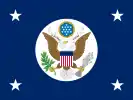
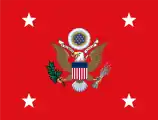
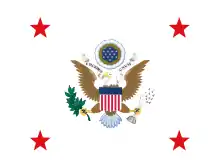
.svg.png.webp)

